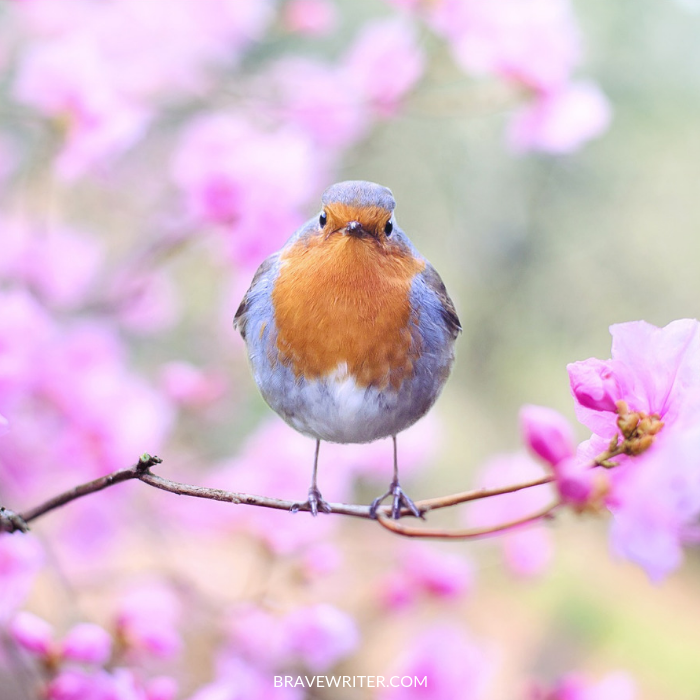The Practice of Happy!

Lots of homeschool literature talks about “delight-directed learning”—the practice of letting your child’s interests and passions guide learning. The philosophy runs like this: If you allow a child to pursue what piques her curiosity or arouses his enthusiasm, that child is more likely to suck the marrow of learning out of that field of interest than if you put information you think the child should learn in front of him or her.
If we follow our children into their delight-directed interests, we often can teach everything else we hope to teach. For instance, I remember that what finally put Caitrin over the hump for reading was the intersection between the Greek alphabet (a fascination of hers!) and a desire to read the article that told her what happened to Nick Lachey and Jessica Simpson’s marriage! (Yes, we live in Cincinnati.)
As you get comfortable with this practice of following your children into their delights and passions, it becomes easier and easier to let your children show you the education they want to have. You, in turn, find ways to enhance that interest and expand it, adding the parts that reassure you that the three R’s are also being mastered.
But what about you, the homeschooling parent?
What if we talk about your delight-directed teaching?
Can you give yourself permission to live in a happy frame of mind on a regular basis, throughout the day?
Do you smile? Find reasons to laugh?
Do you exclaim, “Oh! I love the way the bread dough feels when I squish it between my fingers. And it’s sticky! Watch what I can do with sticky dough all over my fingers.”
Our heads run our homeschools so much of the time.
We are thinking about math during dictation. We’re worried about spelling while the child is reading aloud to us, beautifully. We plan lunch while another child recites times tables. We sweep the kitchen, wipe down the counters, and empty the trash when we can grab a few moments of quiet while children are happy at the table.
But are we happy?
I remember the suggestion to light candles when I did the evening dishes in my sink (in the days before I had a dishwasher). It changed everything. I looked forward to that time: deep warm water and suds, the gentle clinking of silverware, the satisfaction of muck sliding off my white plates, the yellow glow of candles instead of fluorescent lighting, the alone time. For a while, it became my time—my space to regroup. Such a little thing—candles. Yet it helped a chore become a delight for me.
When our family began our bird watching habit, I noticed that I became more tuned into the space beyond my windows. Prior to that, it was as if I lived in a cave! Even though my windows opened to a glorious backyard, I rarely paused to look through the windows. I was too busy in my head planning the next activity, averting the next spill, changing a diaper, and wondering if I’d ever get a full night’s sleep.
Once we added bird feeders, I noticed that I smiled more at the weather outside, too. These feathered friends showed up in large groups in the snow! Changed how I felt about winter.
It takes practice to be a delight-directed teacher. To my way of thinking, it is less about picking topics I love (though that is certainly part of it!) and more about noticing the not-time-bound details of daily living in front of and with my children.
- I can take a walk with them at a snail’s pace and notice the silver trail a snail makes.
- I can enjoy the sounds of squealing toddlers if I can let go of my need to have a complete thought in that moment.
- I can taste my lunch when I sit with my kids to eat.
- I can enjoy hot tea, if I don’t walk around the house with the mug, leaving it at the side of my half-made bed or in the laundry room on the dryer.
I want to be a delight-directed person—not just a teacher, not as a means to an end.
I want to pause and allow for the people I love to surprise me.
I want to stop assigning motives to their actions—a child could be in a hurry, which is why the milk spilled; or a child could be momentarily distracted by the baby’s giggle; or a child could be trying so hard not to spill, she spills! Any of those explanations may be true, but I don’t have to choose the one that makes me angry.
I can allow for ambiguity, I can open myself to the possibility that my children are eager to please me, just as I’m eager to make them happy.
From that frame of reference, we can create a delight-directed homeschool environment, together—with me leading the way.



















[…] if you’ve been reading here long at all, you know that i love Julie at Brave Writer. even though our oldest child is only seven, we have used Julie’s Jot It Down methods with great success. yesterday she posted a wonderful piece about delight-directed teachers. […]